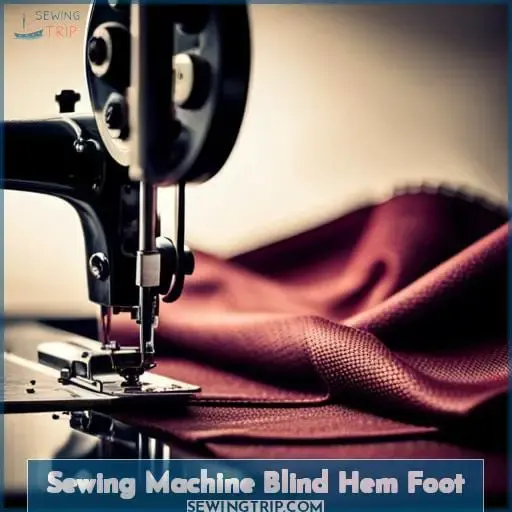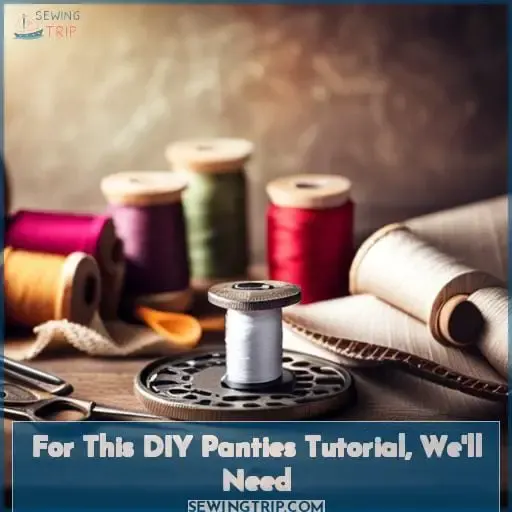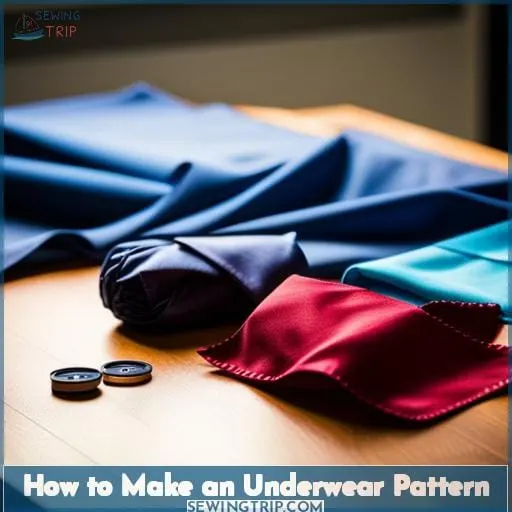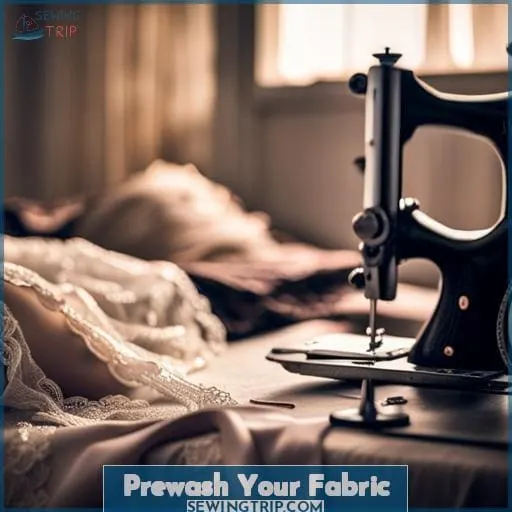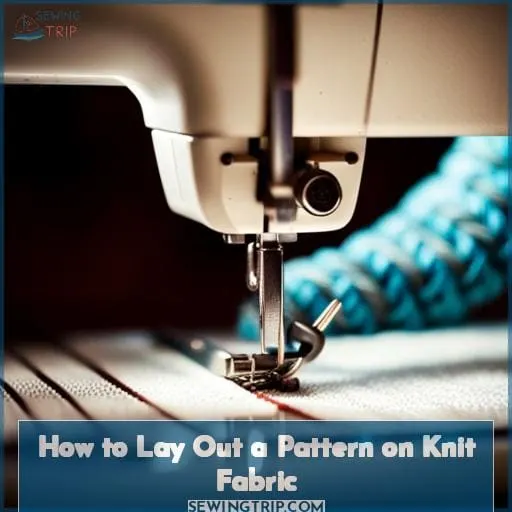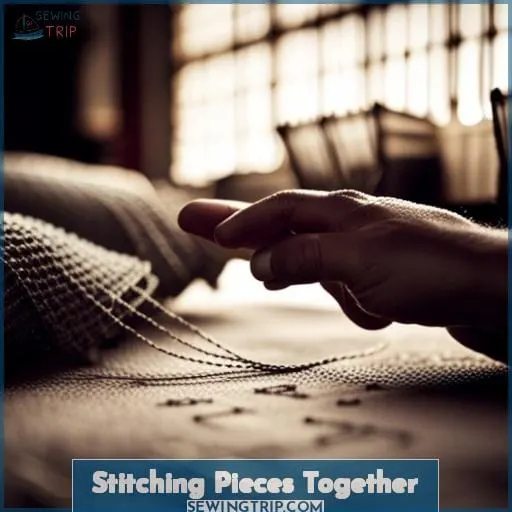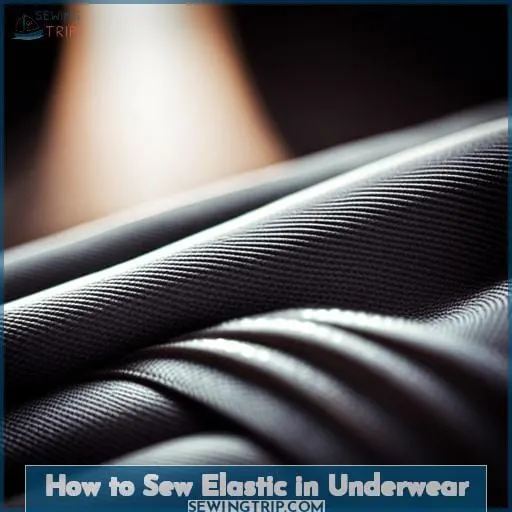This site is supported by our readers. We may earn a commission, at no cost to you, if you purchase through links.
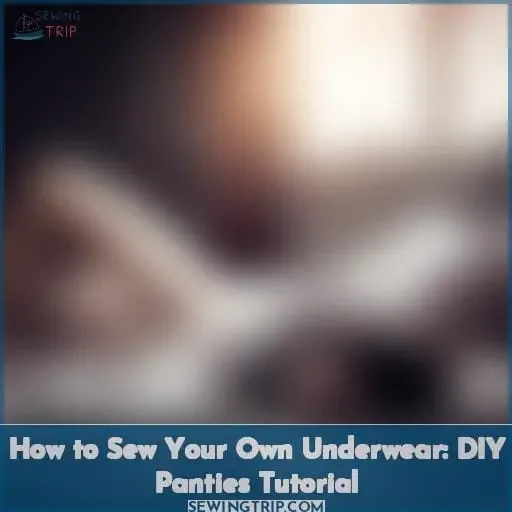 Unleash your creativity and master the art of sewing by diving into the world of DIY underwear. Discover how to sew your own panties with this comprehensive tutorial. Investigate the truth behind making custom-fit, comfortable underwear that perfectly suits your style and preferences.
Unleash your creativity and master the art of sewing by diving into the world of DIY underwear. Discover how to sew your own panties with this comprehensive tutorial. Investigate the truth behind making custom-fit, comfortable underwear that perfectly suits your style and preferences.
From choosing the right elastic trims to stitching pieces together flawlessly, you’ll gain valuable knowledge and skills in creating lingerie that empowers you from within.
Table Of Contents
- Key Takeaways
- Sewing Machine Blind Hem Foot
- For This DIY Panties Tutorial, We’ll Need
- What is Picot Elastic?
- How Do You Measure the Elastic You Need for the Project?
- How to Make an Underwear Pattern
- Prewash Your Fabric
- How to Lay Out a Pattern on Knit Fabric
- Stitching Pieces Together
- How to Sew Elastic in Underwear
- Care Instructions for Period Underwear
- Personalize Your Period Underwear
- Frequently Asked Questions (FAQs)
- Conclusion
Key Takeaways
- Choose appropriate stitches, needles, and fabrics for comfortable and professional-looking underwear.
- Measure and cut elastic trims accurately to ensure a snug fit.
- Create and customize underwear patterns for a personalized and well-fitting design.
- Take proper care of your handmade underwear to maintain quality and longevity.
Sewing Machine Blind Hem Foot
To create flawless blind hems on your DIY panties, start by attaching the Sewing Machine Blind Hem Foot to your sewing machine.
This specialized presser foot is essential for achieving professional-looking finishes on lightweight and medium-weight fabrics. The narrow design of the foot, along with its built-in guide, ensures straight and even blind hems every time you sew.
Using the Sewing Machine Blind Hem Foot requires a few simple steps.
First, select the appropriate stitch length and width on your sewing machine according to your fabric type and desired hem finish.
Next, fold up the raw edge of your fabric to create a double-folded hem that aligns with the guide on the foot.
Once you’ve aligned everything correctly, place both layers of fabric under the toe of the blind hem foot so that they’re sandwiched between it and feed dogs underneath.
continue stitching until completed without stopping midway through unless necessary; doing otherwise could result in uneven stitching lines across
your finished piece—something we all want our DIY projects free from!
Having a Sewing Machine Blind Hem Foot at hand will elevate both
the quality level achievable when applying various techniques like lace elastic application while also ensuring proper underwear care regarding maintaining secure seams over time.
Mastering these sewing instructions is an empowering skillset worth pursuing for anyone looking toward liberation within their wardrobe choices
For This DIY Panties Tutorial, We’ll Need
To start this DIY panties tutorial, you’ll need a few basic materials and tools.
- Gather your sewing machine needles suitable for knits like jersey or ballpoint needles. These will ensure smooth stitching without damaging the fabric.
- Select your desired knit fabric—either 100% silk jersey or organic cotton—for its comfort and breathability.
- Don’t forget to measure out elastic trims for both the leg openings and waistband of your underwear. Picot edge elastic works well for leg openings while wider elastic is ideal for the waistband.
Before getting started with cutting and sewing, consider prewashing your chosen fabric in hot water to remove any sizing or impurities it may have acquired during production. This step also helps minimize shrinkage once the finished underwear is washed later on.
Lastly, make sure you have all necessary pattern creation tools such as paper scissors and pins readily available before diving into this project! By gathering these essential supplies beforehand, you’re setting yourself up for success in creating comfortable DIY panties that fit just right.
What is Picot Elastic?
Choose picot elastic for a delicate and decorative touch on the waistband and leg openings of your homemade panties.
Picot elastic is a type of sewing elastic that features small, scalloped edges, adding an elegant detail to your underwear.
- Comfort: Picot elastic provides a soft and gentle finish against your skin, ensuring maximum comfort throughout the day.
- Durability: This type of elastic is designed to withstand repeated stretching without losing its shape or elasticity.
- Versatility: Picot elastics come in various widths, allowing you to choose the perfect size for different parts of the underwear.
- Style Options: With picot elastics available in different colors and patterns, you can easily match them with your fabric choices or experiment with contrasting combinations.
By incorporating picot elastics into your DIY panties project, you not only enhance their visual appeal but also ensure long-lasting comfort and durability for everyday wear.
How Do You Measure the Elastic You Need for the Project?
To determine the amount of elastic you need for your underwear project, measure the waist and leg openings of your pattern pieces and add a few inches to account for stretching and securing.
-
Measure the Waistband Length:
- Using a measuring tape, measure around your waist where you want the elastic waistband to sit comfortably.
- Round up this measurement to the nearest whole inch or centimeter.
-
Measure Leg Openings:
- Wrap the measuring tape around one leg opening at a time, starting from front center to back center.
- Take note of this measurement.
-
Calculate Elastic Length:
- Multiply each leg opening measurement by 0.75 (to account for stretch) and round it up.
For example: If your leg opening measures 20 inches, multiply it by 0.75 which equals 15 inches rounded up.
Now that you have these measurements in hand, consider different options like using wide elastic or fold-over elastic depending on personal preference and desired style outcome while keeping in mind its application during construction process such as sewing along edges with zigzag stitch.
How to Make an Underwear Pattern
To create your own underwear pattern, start by cutting old panties to use as a template. This will ensure that the new pair fits you perfectly and meets all your comfort needs.
Once you have the template, follow these steps to make an underwear pattern:
- Measure and customize the pattern:
- Take note of any adjustments or modifications you want to make for a personalized fit.
- You can adjust the rise, gusset length, or even add in extra design elements like lace or mesh panels.
- Select fabric:
- Choose a comfortable knit fabric with good recovery that suits your preferences and needs for period underwear care.
- Lay out the pieces on fabric:
- Place your pattern pieces on top of your chosen knit fabric while ensuring it’s not distorted along grainlines (ribs).
- Mark centerlines using pins or disappearing ink so everything lines up correctly when sewing.
- Sew according to techniques:
- Use appropriate sewing techniques such as serger stitches for sewing knits and zigzag stitches when attaching elastic trims at leg openings and waistband.
By making adjustments based on personal measurements/preferences during customization stage; selecting suitable fabrics; applying proper stitching methods like serging/zigzag stitching during construction process – one can achieve well-fitted & comfortable homemade panties!
Prewash Your Fabric
Before you begin sewing your own underwear, it’s important to prewash your fabric. Prewashing helps prevent any unexpected shrinkage and ensures that the final product fits correctly.
To prewash your fabric, follow these washing tips for optimal results.
First, check the care instructions on the fabric label to determine if it can be washed in hot water. If so, wash the fabric in hot water to simulate future laundering and remove any sizing or impurities present in new fabrics.
After washing, observe whether there’s any noticeable shrinkage in the fabric. While most fabrics experience minimal shrinkage after prewashing, it’s still important to assess its impact on pattern symmetry and overall fit before cutting into it.
Additionally, ensure that the fabric remains in good condition after being subjected to hot water. This step will help you avoid potential disappointment later when sewing with distorted or damaged material.
Taking this extra time at the beginning of your panty sewing project will ensure that you achieve professional-looking results without surprises down the line.
Taking proper care of your materials from start to finish is a key aspect of successful DIY lingerie projects.
How to Lay Out a Pattern on Knit Fabric
Now, let’s lay out your pattern on the knit fabric to prepare for sewing your own underwear.
- Fabric Selection: Choose a comfortable and stretchy knit fabric like silk jersey or organic cotton. The right fabric will ensure a comfortable fit and proper recovery.
- Pattern Alignment:
- Identify the grainline on the right side of the knit fabric by looking for tiny parallel lines (ribs).
- Lay out the fabric without distortion, making sure to straighten any ribs that may be uneven.
- Grainline Identification: Mark the centerline of your pattern pieces using pins or disappearing ink. This will help you align them properly with respect to both lengthwise and crosswise grains.
- Symmetrical Layout:
- Place and cut your pattern pieces ensuring they’re mirrored correctly so that you have whole front, back, and gusset/crotch pieces instead of halves.
Remember these tips when laying out patterns on specialty fabrics like silk jersey:
- Take care not to stretch or distort delicate knits while cutting.
- Use sharp scissors or rotary cutter designed specifically for knits.
- Consider cutting single layers if necessary to maintain accuracy.
- Practice precise cutting techniques such as tracing around paper patterns with weights before removing them from underneath.
By following this technique in laying out your pattern on knit fabrics like silk jersey, you’ll be one step closer towards creating custom-fit underwear that fits beautifully.
Stitching Pieces Together
Once you have cut out the front, back, and crotch pieces of your underwear pattern from the knit fabric, it’s time to stitch these pieces together. This is where your sewing skills come into play. Using sewing techniques such as straight stitching or serging with a serger machine, you’ll join these pieces to create a functional and comfortable pair of panties.
When stitching the crotch piece to the front and back pieces, make sure to align them properly for accurate matching seams.
If using a regular sewing machine, choose stretch stitches that allow for movement without breaking. These stitches are specifically designed for knits and will ensure durability in wearability.
For added comfort and flexibility at leg openings and waistband edges apply picot edge elastic using zigzag stretches along those areas while slightly stretching elastic between each pin marking on both sides so there’s no excess bulk when finished panty shows off its beautiful lines!
Remember that different fabrics may require different tension settings on your machine or adjustments in thread type/weight used during construction process – always test first!
How to Sew Elastic in Underwear
To sew elastic in your underwear, align the edge of the elastic with the corresponding opening and secure it using a stretch zigzag stitch. This technique ensures that the elastic stays in place and allows for comfortable movement.
Here’s how to sew elastic in your underwear:
- Start by pinning one end of the lingerie elastic to one side of the leg or waist opening.
- Stretch out and evenly distribute the remaining length of elastic along that opening, pinning as you go.
- Using a stretch zigzag stitch on your sewing machine, carefully sew along both edges of the pinned-down piece while stretching out any excess fabric between pins.
- Once you’ve stitched all around, trim off any excess fabric or loose threads.
Remember to choose appropriate waistband options based on personal preference and comfort levels when sewing custom underwear! Whether it’s fold-over elastics for a clean finish or wide elastics for added support, there are plenty of choices available when it comes to creating an individualized fit.
With these simple techniques and customizable options at hand,you can confidently experiment with different fabrics like mesh panels or customize patterns according to specific needs.
Care Instructions for Period Underwear
To properly care for your period underwear, it’s important to follow these instructions.
First and foremost, check the fabric options you’ve chosen for your DIY panties tutorial.
When washing your period underwear, use cold water on a regular cycle with other laundry items to keep them fresh and clean.
Avoid using bleach or harsh detergents that can damage the fabric or affect its absorbency properties.
Hang-drying your period underwear will help maintain their shape and prevent shrinkage or warping of elastic trimmings.
When personalizing underwear with different elastics like picot edge elastic for leg openings, make sure to select high-quality options that won’t lose their stretch over time.
It’s important to note that caring for reusable products like period underwear has a positive impact on sustainability by reducing waste from disposable alternatives. By following these care instructions diligently, you’ll be able to enjoy long-lasting wear from your handmade creations while contributing positively towards protecting our environment.
Personalize Your Period Underwear
Now that you know how to care for your period underwear, it’s time to explore the exciting world of personalization. By customizing your period underwear, you can’t only make them uniquely yours but also enhance their comfort and functionality.
There are several options available for personalizing your period underwear:
- Customization options: Take advantage of design variations and customization features to create a pair of panties that perfectly suits your style and preferences.
- Comfort features: Experiment with different waistbands, leg openings, or fabric choices to ensure maximum comfort during menstruation.
- Color choices: Choose colors that bring joy and positivity into your life while still maintaining practicality.
- Pattern adjustments: Modify the pattern according to individual measurements or desired fit.
By incorporating these personalized touches into your homemade period underwear, you can elevate both their aesthetic appeal and functional performance. Whether it’s adding cloth pads for extra protection or incorporating a leakproof layer in strategic areas like the gusset region – there are endless possibilities when it comes to making each pair truly unique.
Additionally, using absorbent materials like Zorb combined with moisture-wicking fabrics such as lycra jersey ensures optimal absorption without sacrificing breathability.
So go ahead and unleash your creativity! Personalize Your Period Underwear today by exploring various customization options ranging from color choices all the way down through pattern adjustments – because nothing says empowerment quite like having complete control over what goes against our bodies every month.
Frequently Asked Questions (FAQs)
What are some alternative options for waist and leg finishes in period underwear?
Consider alternative waist and leg finishes for period underwear like fabric bands or fold-over elastic.
These options allow you to:
- Personalize your design
- Reduce waste
- Create a comfortable fit that empowers you during your menstrual cycle.
How often should period underwear be changed and how should they be cared for?
Period underwear should be changed every 8 hours or less, keeping you feeling fresh and confident all day.
Rinse them in cold water after use and wash inside out on a regular cycle for proper care.
What are some ways to personalize period underwear?
Personalize your period underwear:
- With stretch lace for comfort
- With picot elastic for a glam touch
- With mesh panels to make a statement
Adjust the rise and gusset length to suit your preferences.
Empower yourself through customization!
Can you provide tips on adjusting the rise and gusset length of underwear patterns?
To adjust the rise and gusset length of underwear patterns, simply modify the pattern by:
- Removing seam allowances
- Using lengthen/shorten guides
This allows you to customize your fit for ultimate comfort and empowerment in creating your own unique underwear.
Can you tell us more about Wallis Smith-Owens and her involvement in patternmaking?
Wallis Smith-Owens, a passionate patternmaker at our organization, contributes to designing and creating patterns. She finds joy in seeing what people create using her drafts. Her love for sewing empowers individuals through sustainability and creativity.
Conclusion
To conclude, sewing your own underwear is a liberating and empowering journey towards self-expression.
By following this comprehensive DIY panties tutorial, you can create custom-fit lingerie that perfectly suits your style and preferences. From choosing the right elastic trims to stitching pieces flawlessly, you’ll gain valuable knowledge and skills in the art of sewing.
So unleash your creativity, dive into the world of DIY underwear, and master the art of sewing your own panties. Start today and embrace the joy of creating lingerie that empowers you from within.

